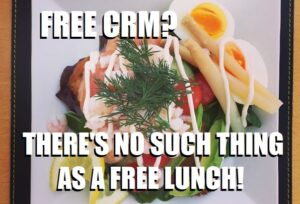Did you know that there are companies who offer FREE CRM? That’s right – in a market where top vendors have combined sales measured in billions of dollars, there are companies who can provide CRM for FREE. If you are considering CRM for your business, where does FREE CRM fit?
There’s no such thing as a free lunch!
It’s an aphorism (an observation that contains a general truth) but worth investigating whether CRM software vendors have really found a way of making CRM free to users. Could there be a way of eliminating all costs from your CRM project? Sadly, but unsurprisingly, the answer is “No” – but FREE CRM is out there and is offered by a number of companies. So why do they give away software, and where are the costs?
Puppy dog sales
For anyone with a classical sales background, the idea of a “puppy dog sale” is familiar. It is suggested that if you sell puppies, the easiest route to a sale is by giving the puppy to someone for a short period of time, and then asking for it back with the tills ringing. So for some CRM vendors, offering a limited time free use licence is a useful way of hooking in new customers. If you have gone through the hard work of importing data and setting up the system so that it’s delivering a business benefit, then you will probably be happy to pay something to keep the system and access to your data!
Hidden costs to watch for
- Price “gauging” when you want to increase the number of users, or renew after the “free” period
- Higher internal costs in terms of effort to get the system live
- Infrastructure costs – so while the software may be “free” the hardware to run it on may not be
Sprats to catch mackerel
A slightly more fishy approach being adopted by some software vendors is to provide a free or low cost CRM tool to complement their main product offer. In the past, Accounting Software companies were leaders in this area. Having saturated the available users in the Accounts department, they looked for other areas where they could expand their footprint. While giving away CRM may not at first seem like a particularly profitable business model, all those sales users potentially needed a licence to the core accounting software. More importantly, it allowed the Finance Director to gain control and oversee the sales department, so was perceived as a benefit by the traditional buyers of accounting software.
Hidden costs to watch for
- Requirement to increase the number of licences for another product in order to access the free product
- Higher costs of operation as the system is not designed to support efficient operation by sales people
- Lack of sales and marketing focus in the application leading to increased translation / training costs to get people to use the “free” software
Upgrade to viability
For specialist CRM vendors keen to grow their user population, the SMB market is highly attractive. This large untapped audience has so far managed to resist some of the market leading CRM tools. Primarily this is a reflection of the high cost of purchase and operation of such systems. There is a current line of thought that by providing software with limited functionality, vendors can reduce the licence prices without compromising their corporate customers who are paying top dollar for their software. By reducing the functionality they can also reduce the cost of implementation and the amount of consultancy required to go live.
Hidden costs to watch for
- The feature you need requires an upgrade to the “full version” of the product
- The feature you need is not available at all in the “free” version, requiring the development of parallel systems just to get the job done
- Implementation partners are used to the kind of day rates paid by massive corporations – so you never get their best people
Offshore providers
If much of cost of implementing CRM relates to the skills and expertise required to get the best from the software, then sourcing labour from low wage economies could help reduce those costs. These vendors will offer “free” or cheap CRM tools with limited functionality as a platform on which you can build your perfect CRM system. The low cost of off-shore developers, they suggest, means that even if the project takes longer it could cost less.
Hidden costs to watch for
- Being charged to develop functionality that is included in other CRM tools
- Developing what you ask them to, not what you need
- Misunderstanding the specification you provide – leading to wasted development and time
The real cost of “free” CRM will vary depending on how you approach the project. In general, if the product is not supported, developed and maintained then you will incur costs at a future date when the software author goes bust. And they will go bust, because skilled developers, testers, sales and marketing people cost a lot of money. So if you are not paying for the software where does that money come from? Perhaps the final, and most worrying cost of FREE CRM, is one we have all learnt from social media. If you cannot see the price of the product, then you are the product!





